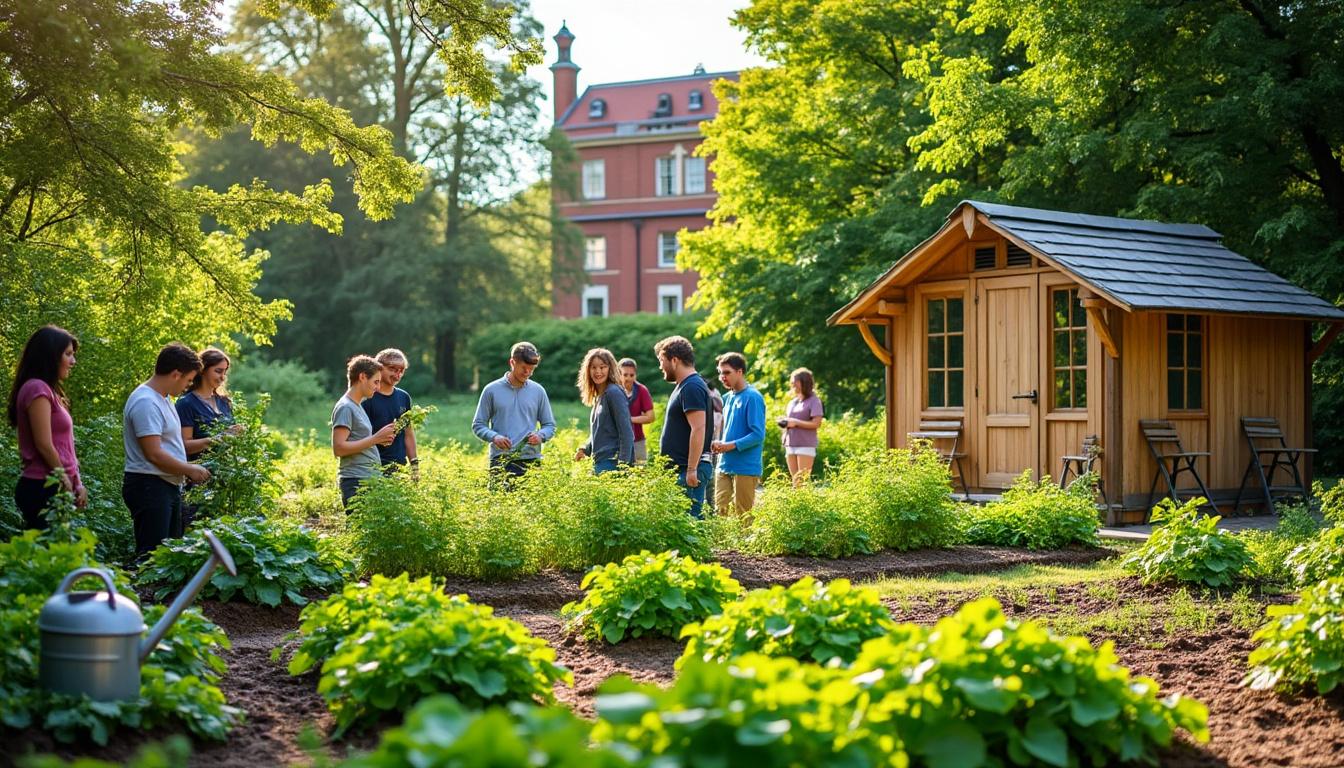The resurgence of interest in organic farming and sustainable gardening practices is reshaping how communities engage with nature and food production. At Oxford College, the Organic Farm serves as a beacon for gardeners, both novice and experienced, seeking to cultivate thriving gardens that prioritize soil health, crop rotation, and eco-friendly plant care. As spring breathes life into the campus, the farm’s seasonal rhythms inspire a wealth of gardening tips perfectly aligned with the challenges and opportunities of 2025. With a focus on empowering gardeners through actionable guidance, this overview delves into six indispensable gardening tips cultivated from the farm’s rich expertise.
Embracing Freshness: Prioritizing Local and Seasonal Harvest in Organic Farming
One of the foundational principles of organic farming at Oxford College is a commitment to freshness, which profoundly affects the taste and nutritional value of homegrown produce. Vegetables harvested and consumed swiftly retain vibrant flavors and heightened aromas that supermarket produce often lacks. Carrots, for example, typically lose their sweetness and fragrance rapidly when stored after transport and shelving. At the farm, carrots freshly pulled from the soil display a robust sweetness due to the preservation of natural sugars.
Understanding this difference encourages gardeners to focus on seasonal planting and harvest schedules such as those promoted in local community-supported agriculture (CSA) programs. By timing planting and harvest to maximize peak freshness, gardeners can experience produce at its optimum quality. The Oxford College Organic Farm’s popular spring plant sale on April 12 serves as an excellent opportunity to procure seedlings suited for immediate seasonal planting.
Adopting local and seasonal cultivation methods offers multiple benefits:
- Enhanced Flavor and Nutrition: Produce reaches its full potential in taste and health benefits when not subjected to long storage or transport.
- Reduced Carbon Footprint: Growing seasonally and locally cuts down on emissions from transportation and refrigeration.
- Access to a Greater Variety: Home gardeners are free to grow heirloom and less-commercialized varieties prized for flavor rather than shipping durability.
A practical approach to embracing freshness also involves extending plant care knowledge beyond the growing season. Proper composting and maintaining soil health ensure that plant vitality returns year after year, contributing to a sustainable gardening ecosystem. For garden layouts optimized for freshness, resources such as gardening tips for beginners offer foundational support on planning and executing successful seasonal planting.
| Produce | Peak Freshness Time | Flavor Profile | Common Storage Effect |
|---|---|---|---|
| Carrots | Within hours of harvest | Sweet, aromatic | Deteriorates to bland and hardening |
| Tomatoes (Sungold cherry) | Immediately after ripening | Bright, sweet, and juicy | Softening and loss of flavor over days |
| Herbs (basil, thyme) | Daily harvesting | Fragrant and fresh | Wilt and flavor loss when stored too long |
Starting Your Garden Right With Herbs and Container Plants For Sustainable Gardening
For aspiring gardeners, particularly those constrained by limited space or time, initiating a garden with herbs and container plants is an effective way to build confidence while embracing sustainable gardening principles. Herbs such as thyme, rosemary, mint, and basil not only thrive in pots but also offer multi-seasonal yields. Their perennial nature (except for basil, which is annual) allows gardeners to reap benefits throughout various seasons by the simple practice of regular harvesting.
Indoor or windowsill herb gardens represent a compelling choice for urban gardening enthusiasts. By positioning pots in well-lit areas, gardeners can keep their plants healthy year-round, benefiting kitchens with fresh, aromatic ingredients. Additionally, container gardening aligns well with sustainable gardening, enabling easier management of soil quality and water use while allowing for crop rotation at a smaller scale.
Key reasons to begin with herbs and pots include:
- Manageable Commitment: Smaller scale planting reduces time and resource demands.
- Space Efficiency: Perfect for urban dwellers, apartments, or those without garden plots.
- Easy Pest Control: Potted herbs experience fewer pest and disease issues, reducing the need for intervention.
- Year-Round Use: They can flourish indoors or outdoors depending on environmental conditions.
Evergreen culinary staples like rosemary and mint act as natural air fresheners and pest repellents, while annuals like basil provide vibrant seasonal flavors ideal for dishes like homemade pesto. The farm’s expertise reinforces that beginner gardeners who start small gain essential skills that lead to greater gardening success.
| Herb | Growth Type | Cultivation Environment | Planting Tips |
|---|---|---|---|
| Thyme | Perennial | Indoor/Outdoor, sunny | Well-drained soil; moderate watering |
| Rosemary | Perennial | Outdoor, sunny | Dry soil tolerance; prune regularly |
| Mint | Perennial | Indoor/Outdoor, indirect sunlight | Keep moist soil; contain spread |
| Basil | Annual | Indoor/Outdoor, sunny | Warm soil; pinch for bushier growth |
Additional inspiration and ideas for compact garden planting can be found at Compact Garden Ideas, equipping gardeners with innovative layouts for maximizing limited space effectively.
Soil Health and Preparation: The Foundation of Sustainable Gardening at Oxford College Organic Farm
Quality soil preparation forms the cornerstone of any successful garden, a truth well embraced by the Oxford College Organic Farm. Soil health directly influences plant vigor, pest resilience, and overall crop yield. Before planting, soil testing is paramount, offering vital insights into nutrient balances and deficiencies. The University of Georgia Cooperative Extension’s soil testing services serve as a reliable model, guiding gardeners in refining their soil amendments for optimal plant growth.
The process involves collecting representative soil samples from various garden sections, mixing them, and submitting the composite sample for laboratory analysis. The resulting recommendations enable gardeners to precisely apply amendments such as compost, lime, or specific minerals to create an ideal growing environment.
Once armed with soil test results, gardeners may employ methods such as “double digging” — a labor-intensive technique that involves loosening soil to improve aeration and encourage root development. While raised beds are popular for their convenience, planting directly in the ground is often favored by experts for better nutrient retention and natural soil biodiversity.
Vital components for soil health include:
- Organic Matter: Composting household and garden waste boosts nutrient content and fosters beneficial microbes.
- Crop Rotation: Alternating crops to prevent soil nutrient depletion and disrupt pest lifecycles.
- Proper Drainage: Ensures roots do not become waterlogged, avoiding rot and disease.
- pH Balance: Maintaining soil pH within crop-appropriate ranges supports nutrient uptake.
For gardeners aiming to deepen their understanding of soil amendments and sustainable planting, specialized resources such as Planting Tips for Different Climates provide tailored advice for adapting soil health practices based on local conditions.
| Soil Component | Purpose | Common Source | Effect on Plants |
|---|---|---|---|
| Compost | Enhance nutrients and microbial activity | Decomposed organic waste | Improved fertility and soil structure |
| Lime | Adjust soil pH | Calcium carbonate | Optimizes nutrient availability |
| Organic Mulch | Moisture retention and weed suppression | Straw, leaves, wood chips | Protects roots and soil microbes |
| Green Manure (cover crops) | Restore nutrients and prevent erosion | Legume or grass cover crops | Boosts nitrogen and soil organic matter |
Planting Strategies and Crop Rotation: Maximizing Yield and Soil Longevity
Implementing effective planting strategies, including crop rotation, is integral to maintaining soil health and maximizing garden productivity at Oxford College Organic Farm. Crop rotation disrupts pest and disease cycles and balances nutrient expenditure across planting seasons, ensuring long-term soil fertility.
The farm practices thoughtful crop sequencing, placing nutrient-demanding plants like tomatoes and peppers following legumes, which help fix atmospheric nitrogen in the soil. This practice exemplifies sustainable gardening by reducing reliance on synthetic fertilizers and fostering a resilient garden ecosystem.
Senior gardeners recognize the importance of matching plant selections to seasonal cycles. For example, early-season vernal crops such as broccoli and cabbage benefit from soil replenishment periods prior to planting. This seasonal planting approach encourages thriving harvests and aligns with natural growth rhythms.
Essential considerations for crop rotation and planting include:
- Grouping Plants by Family: Rotating within and between botanical families limits disease spread and nutrient depletion.
- Incorporating Cover Crops: Green manures help restore nitrogen and organic matter during off-seasons.
- Timing Planting with Seasonal Conditions: Ensures that plants grow during optimal temperature and light periods.
- Using Companion Planting: Enhances pest control and nutrient sharing amongst compatible species.
| Crop Family | Example Plants | Rotation Recommendation | Soil Impact |
|---|---|---|---|
| Legumes | Peas, beans | Follow heavy feeders | Fix nitrogen, enrich soil |
| Solanaceae | Tomatoes, peppers, eggplant | Rotate every 3-4 seasons | Moderate nutrient usage |
| Brassicaceae | Cabbage, broccoli, collards | Avoid repeating annually in same spot | Heavy feeders; deplete nitrogen |
| Alliums | Onions, garlic | Rotate with legumes or grasses | Suppress pests; moderate nutrient use |
Gardeners looking to master crop rotation and seasonal planting can find detailed guidance at Gardening Tips Lancaster which offers climate-specific planting schedules and crop sequences.
Choosing Varieties: Starting with Easy Crops and Expanding to Native and Heirlooms
Oxford College Organic Farm encourages gardeners to tailor their plant selections according to experience and goals, blending accessibility with adventurous choices. Beginners are advised to begin with forgiving, high-yield crops like Sungold cherry tomatoes, known for their sweet flavor and ease of cultivation. These tomatoes provide quick gratification and reliably encourage continued gardening efforts.
Experienced gardeners may take on heirloom varieties such as Cherokee Purple or Rose de Berne tomatoes, which offer distinctive flavors but require attentive care and disease management. These heirloom plants are typically larger with longer maturation periods, making sharing harvests with friends and family a rewarding social aspect of gardening.
In addition, incorporating native plants like golden alexander or spotted horsemint bolsters the garden’s habitat health by attracting beneficial pollinators and natural pest controllers, enhancing overall sustainability. The Oxford spring sale showcases a diverse selection of these plants along with other crops such as picnic peppers, Ping Tung Long eggplants, and dark green zucchini, providing ample choices for gardeners to expand their green repertoire.
Variety selection benefits include:
- Increasing Flavor Diversity: Heirlooms often offer richer and unique tastes compared to commercial hybrids.
- Supporting Biodiversity: Native plants integrate with local ecosystems to improve resilience.
- Encouraging Garden Renewal: Trying new varieties motivates reflection on plant care and soil health adaptation.
- Building Community through Sharing: Heirloom harvests encourage social engagement and plant exchanges.
| Variety Category | Examples | Skill Level | Key Considerations |
|---|---|---|---|
| Beginner-Friendly | Sungold Cherry Tomato | Easy | High yield, disease resistant, suitable for containers |
| Heirloom Tomatoes | Cherokee Purple, Rose de Berne, San Marzano | Intermediate to advanced | Disease susceptible, larger fruit, longer maturation |
| Native Plants | Golden Alexander, Spotted Horsemint | All levels | Pollinator friendly, pest deterrent, drought tolerant |
For gardeners eager to explore heirloom varieties and native plants, Myddleton House Gardening offers inspiring approaches and planting plans suited to varied gardening ambitions.
FAQ About Organic Gardening Based on Oxford College Tips
- Q1: Why is soil testing important before planting?
A1: Soil testing identifies nutrient deficiencies and pH imbalances, allowing gardeners to adjust soil health accordingly for optimal plant growth and sustainable gardening outcomes. - Q2: How can beginners ensure success with their first garden?
A2: Starting with easy-to-grow crops like herbs or Sungold cherry tomatoes and practicing good soil preparation can build confidence and increase success rates. - Q3: What are the key benefits of crop rotation?
A3: Crop rotation prevents pest buildup, maintains soil fertility, and promotes healthier plants by alternating nutrient demands across planting seasons. - Q4: How do native plants contribute to organic gardens?
A4: Native plants attract pollinators and beneficial insects, support biodiversity, and reduce the need for chemical pest controls. - Q5: What is the advantage of growing heirloom varieties?
A5: Heirlooms provide unique flavors and genetic diversity, enriching the garden’s character but require attentive plant care.

